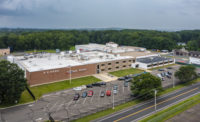
Basically unseen today, about 20 years ago, natural gas-driven compressors were a common sight in U.S. dairy processing plants. With the availability of relatively cheap electricity and rising natural gas prices, nearly all of these maintenance-intensive units were removed from service. These days, it is rare to see one operating in a dairy processing plant, though they do exist. Now, the drive for increased sustainability in our dairy industry and changes in market forces make this old workhorse worthy of a serious second look.
With the advent of fracking and the wealth of shale gas feeding into our pipelines today, we have seen the price of natural gas at the wellhead drop from a historical high of more than $12 per decatherm in late 2005 to less than half that today. Meanwhile, electric prices have continued an unabated climb skyward. This gap between gas and electricity puts on-site power generation and supplemental heat generation - known as cogeneration - back in the black again for many parts of the country.
Gas-engine driven compressors (GEDC) are functionally the same as installing an on-site cogeneration unit, but better. Rather than generating electricity, they avoid the consumption of electricity. This creates the same net effect at the facility’s meter. Rather than having the engine drive a generator to produce electricity (with some losses) that then feeds into the plant’s electrical system, only to be consumed by the large electric motor (with additional losses) on a refrigeration compressor, why not have the engine drive the compressor directly?
The advantages of this approach are dual. First, you avoid the electrical losses associated with the conversion of mechanical work to electricity and then back again, which at best will likely amount to about 10%. Second, you avoid many costly components. For example, there would no longer be a need for a large electrical generator, electric motor, starter, auto disconnect and other associated electrical controls. Anyone who has installed on-site generation is well acquainted with all of the hoops, hurdles, equipment and often fees (in the form of standby charges) required by utility companies to tie into the electrical system. These requirements are in place so that they can ensure safety and quality of the power on their grid, and in some cases, to prevent you from becoming a competitor of theirs. Because a GEDC does not actually produce electricity, these headaches can often be avoided.
Natural-gas engines produce a lot of heat. But in a food plant, this is an advantage. All dairy processing plants use a lot of hot water. The heat generated by the gas engine can be recovered from the engine jacket as well as from the engine exhaust. Jacket water is typically 170ºF, while the exhaust from the engine can range from 700ºF to more than 1,000ºF, depending on whether or not the engine is turbo-equipped. Recovering heat is one thing. Being able to match the timing of that heat production to the consumption need is another issue. This is where a storage tank comes in handy. Proper compressor sizing and heat recovery system design are critical to maximize the savings actually achieved.
Compared to a typical power plant, where nearly all of the waste heat is thrown away, on-site cogeneration is a real winner from an environmental standpoint. Your average coal-fired or nuclear power plant rejects approximately two-thirds of the energy input to the environment and one-third goes to producing electricity for a net efficiency of around 33%. Compare that to a cogeneration system where you are using the mechanical work to avoid electric consumption and the waste heat to avoid boiler energy, and now you have a system that can be as high as 80% thermally efficient. In addition, natural gas is rich in hydrogen and lighter on carbon than the standard electricity coming from the power grid. This, coupled with the efficiency gains of cogeneration, makes a GEDC a significant greenhouse gas reducer.
Make no mistake; there are maintenance requirements of natural-gas engines that will be significant. This should be factored in to the overall cost-benefit analysis. Even with these costs factored in, a plant could expect to see a return on investment as quickly as two years with the average being in the two- to six-year range. Return on investment will depend on local electric and natural gas prices; rebates and incentives; facility size; hours of operation and installation specifics.
As we look forward, let’s also take a look backwards for solutions. You never know what you will find.
Clay Detlefsen is vice president for regulatory affairs for the International Dairy Foods Association, Washington, D.C.

